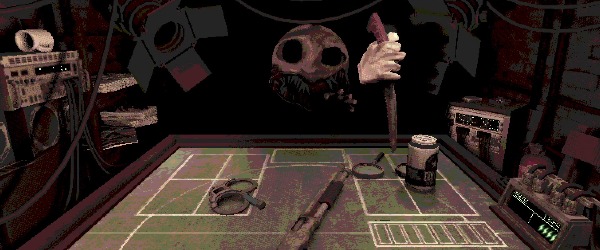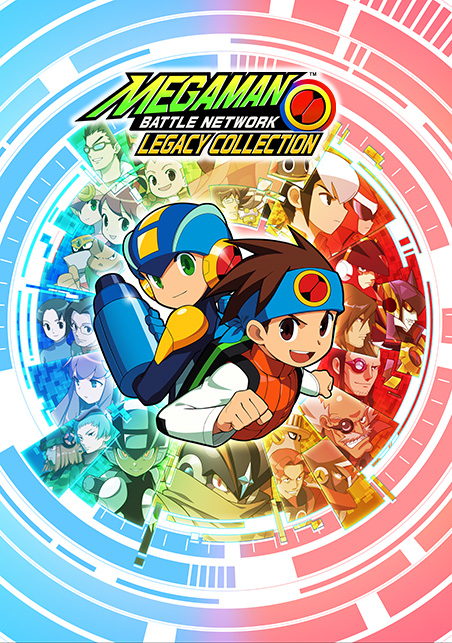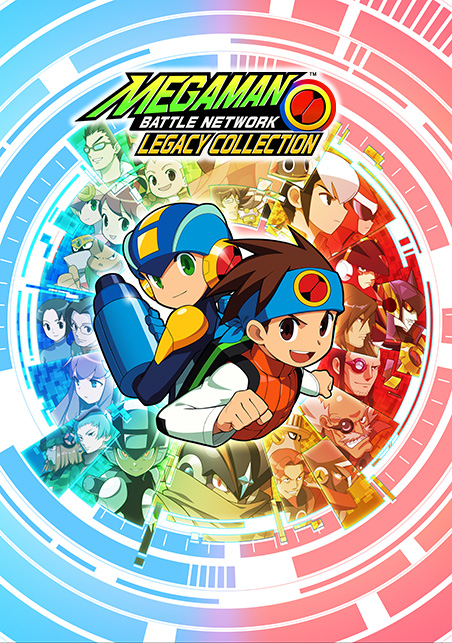
Mega Man Battle Network Legacy Collection (NS) - Review
by Evan Norris , posted on 13 April 2023 / 4,217 ViewsThe Mega Man Battle Network Legacy Collection launches with great timing. Less than three weeks from the closure of the WiiU eShop, which for nine years housed the only digital versions of the 10 Game Boy Advance Battle Network role-playing games, the Legacy Collection arrives to provide a more permanent electronic (and physical) home for the saga — not to mention the removal of some serious FOMO for any WiiU owners who missed the March 27 cut-off.
For those of you out there counting, the Legacy Collection boasts 10 total games, four of them being paired variants in the style of Pokémon. There's the original Mega Man Battle Network, its sequel Mega Man Battle Network 2, the third installment Mega Man Battle Network 3 in both Blue and White versions, Mega Man Battle Network 4 in both Red Sun and Blue Moon versions, Mega Man Battle Network 5 in both Team ProtoMan and Team Colonel versions, and, finally, Mega Man Battle Network 6 in both Cybeast Falzar and Cybeast Gregar versions. In general, just as with Pokémon, it's not essential to play through each game's complementary variant. That said, each version does include exclusive chips, bosses, cosmetics, and, in some cases, story beats. Furthermore, the collection simply wouldn't be complete without them.
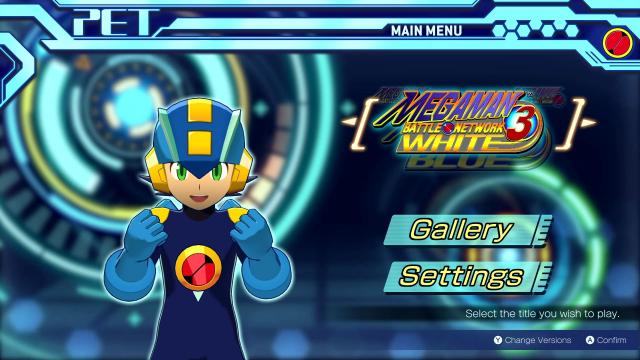
The Legacy Collection is far more than just a simple compendium of 10 GBA games, however. Yes, it includes Mega Man Battle Network 1-6, and all the variants therein, but it also assembles them lovingly in an accessible, feature-rich compilation that elevates the original titles. From the main screen you can choose to dive into your game of choice, or explore elsewhere, including a gallery of over 1,000 illustrations, concept designs, and promotional materials, and a music player stuffed with 188 songs taken from the Battle Network games.
Even more importantly, the anthology pulls together all the Japan-exclusive "Download Chips" and "Patch Cards" previously available only at special events or in stores. This covers 15 chips to be used in single-player and multiplayer battles, and 499 cards that either power up Mega Man's stats, grant items like BugFrags, or summon a super-powerful boss. The programmers at Capcom even went the extra mile and included the special Boktai tie-in cards. The inclusion of all this limited edition content, much of it formerly tied to e-Reader functionality, is a huge boon for the Legacy Collection. It makes the compilation feel exhaustive and definitive.
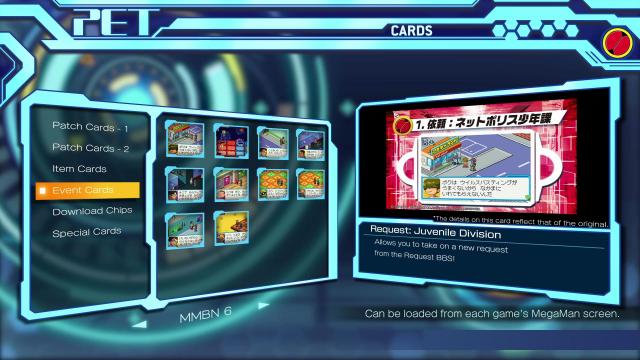
Only adding to that feeling is the collection's online infrastructure. Previously, in the GBA era, two players could connect their systems via Link Cable and battle or trade chips, again in the spirit of Pokémon. Capcom has overhauled and greatly enhanced the 10 games' multiplayer offerings, allowing worldwide online battling and trading. From any individual game's pause menu you can enter an online server, in the region of your choice, and then fight in any combination of public/private and ranked/casual matches. If you're truly daring you can even set the rules so that the losing player has to forfeit a battle chip. There's also an online marketplace where you can trade chips, publicly or privately. This all represents a huge expansion of the original series' multiplayer framework, and another way in which the Legacy Collection makes these 20-year-old games more interesting and accessible than ever before. Unfortunately, due to the low player count on Switch before launch, I was unable to experiment fully with these options.
It should be apparent by this point that the Legacy Collection is the ultimate way to experience the 10 mainline Mega Man Battle Network games from the GBA days. Its only problems, really, are the games themselves. There's nothing bad here — all titles fall in the decent to good range — but nothing truly great.
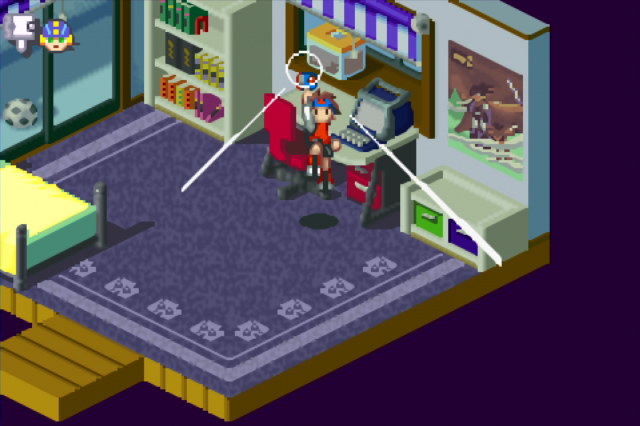
Here's a quick primer, for the uninitiated. Each game in the Mega Man Battle Network series is set in a future world where humans manage, via their personal tablets, virtual avatars called NetNavis in the vast worldwide internet. The star of the show is schoolkid Lan Hikari who, along with his NetNavi Mega Man, consistently saves the day from villains bent on world domination. The storylines are incredibly goofy, but charming in a way. Gameplay is split between Lan's real-world exploration and Mega Man's virtual dungeon-diving, where he collects Battle Chips to deploy in real-time grid-based battles against viruses and rival NetNavis. Mega Man Battle Network is essentially a hybrid of a card-collecting game and a tactical RPG, all wrapped up in a very kid-friendly story, which helps explain the popularity of the franchise in the early aughts.
Each title has qualities both good and bad. On the positive side, the card-collecting and battling mechanics buoy the Battle Network games considerably, and provide in each adventure a surprisingly deep tactical experience. On the negative side, the virtual dungeons are maze-like, difficult to navigate, and filled with a few too many random encounters against low-level viruses. Capcom, in its wisdom, did add an optional "Buster Max" mode to this collection, which boosts the power of Mega Man's pea shooter by a factor of 100, allowing players to dispatch almost any enemy in a matter of seconds. It's basically a "casual" mode for folks focused on enjoying the story. While it removes a huge amount of tedium, it also eliminates any sense of challenge, so it's not for everyone.
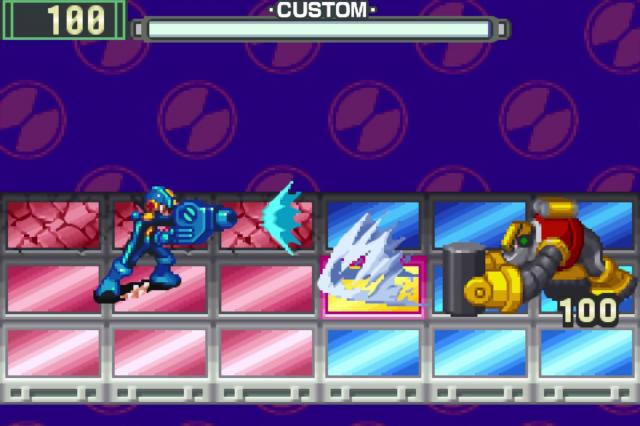
Another issue with the games, which will reveal itself as you play through them in order, is how little they change from sequel to sequel. If you're thinking about investing in the Mega Man Battle Network series, understand that it's defined by conservative iteration, not exciting upgrades. Even when the franchise did diverge slightly from the norm, as it did with Red Sun/Blue Moon and Team ProtoMan/Team Colonel, the changes introduced were for the worse.
If you like the basic formula and characters, though, you're in for a treat. There is an extraordinary amount of Battle Network goodness in this collection — 20-30 hours per game, or about 150 hours total if you play only the six main games without variants. When you factor in online battling and trading, you could in theory play this collection for as long as it maintains an active player base. For anyone on the fence about spending $60 for the anthology, note that you can purchase the Legacy Collection in two separate digital volumes at $40 each. The full collection is absolutely worth the price of admission, but if you have to choose go with Vol. 1, which contains Mega Man Battle Network 2 and 3, arguably the highlights of the series.
If you missed the Battle Network saga on GBA in the early to mid 2000s, and overlooked them again on the WiiU Virtual Console, now is your chance at redemption. Never before has the series been so approachable, enjoyable, or complete. If you're brand new to the Battle Network universe, this is the perfect excuse to jump in — or jack in, in the game's parlance. If you're a veteran who wore out your cartridges back in the day, there are plenty of reasons to return to the world of Lan and Mega Man, including expanded multiplayer offerings and previously hard-to-find "patch cards". While the games themselves aren't outstanding, the effort to enhance and preserve them certainly is.
This review is based on a digital copy of Mega Man Battle Network Legacy Collection for the NS, provided by the publisher.











